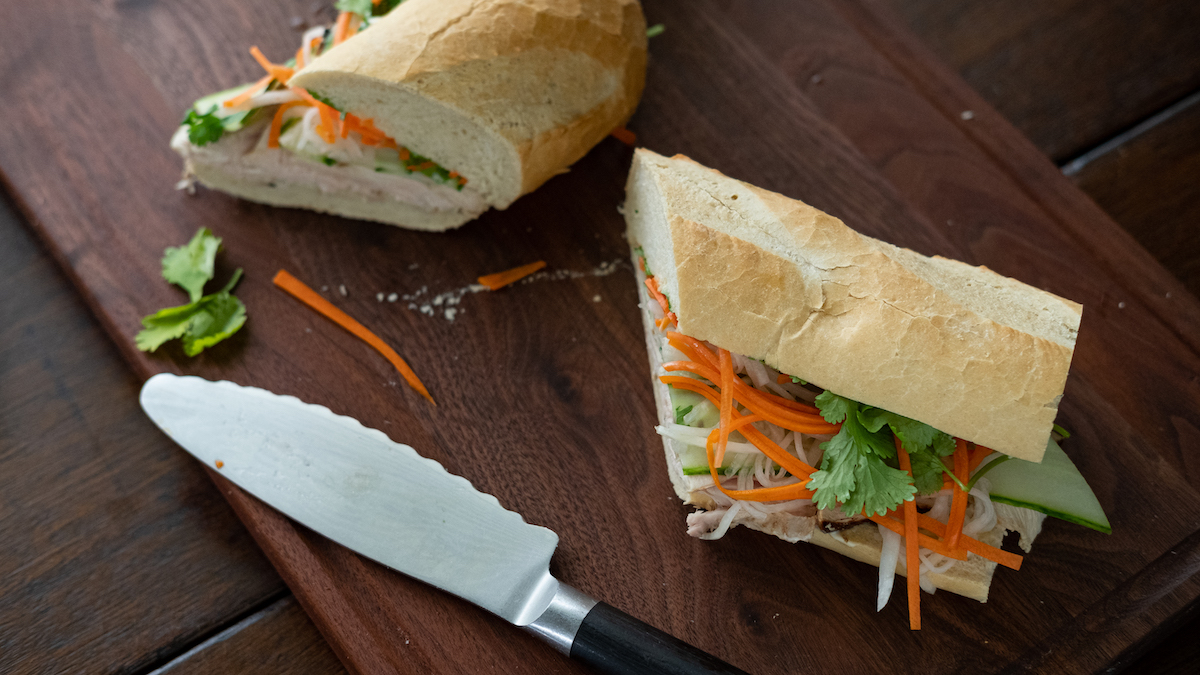
Bánh mì, the Vietnamese equivalent of a hoagie, sub, or grinder, is a beautiful example of what happens when two distinct culinary cultures blend.
Bánh mì translates to “baked” and “wheat” or “bread.” At its core, it's a french baguette filled with Vietnamese ingredients. Crispy bread, pickled veggies, roasted meat, pâté, and savory mayo make this sandwich stand out from your usual cold cut. It’s an edible manifestation of two distinct food cultures wrapped in carbohydrates. It’s an East meets West kind of a thing, complete with classic French bread, Southeast Asian ingredients, adaptation, and improvisation. It’s a refreshing take on a timeless food, and it works even better when you introduce some American wild game.
The French baguette was made popular in Vietnam in the late 18th century during the European occupation of the Asian nation. It’s been a staple food item since and has adapted and taken on its own distinct characteristics. Rice flour is often blended with wheat flour when making the dough, which makes the already crusty bread lighter and crispier. All your classic sandwich characters are present, though represented in a unique, South Pacific way.
Baguette
The most important part of a good bánh mì might be the bread. Finding or making a French baguette that is airy and fluffy on the inside with a thin, extra-crispy exterior is not always easy. If you have access to a bakery, look for rice flour baguettes or ask the bakers for recommendations. Baguettes that are too dense or too soft ruin the textural experience of the sandwich. You want the crust to explode when you bite into it—there should be crumbs everywhere when you're eating one of these.
Protein
The protein part of the bánh mì can range from grilled chicken to liver pâté, or head cheese to barbequed pork. The commonality is robust flavor. Meats are generally marinated before cooking, or in the case of pâté or head cheese, already have an assertive flavor presence. I prefer a soy or hoisin--based marinade for the grilled meats but the world is your oyster, just keep in mind you’ll need strong flavors to pair with the pickled veggies. Smoked wild turkey breast marinated with soy sauce, spicy chili peppers, and lime juice is my go-to bánh mì protein.
Mayo
Like most popular sandwiches, a good bánh mì is all about balancing texture, flavor, and structural integrity. Mayo is often blended with chilis or soy sauce to give it more depth, and it also prevents some excess moisture from seeping into the bread, keeping it fluffy. Mayo also adds fat and richness to the overall dish.
Accoutrements
Picked carrots and radish are constants in a bánh mì. Also known as “do chau,” they add crunch and acid in much the same way pickled cucumbers or onions do to Western sandwiches.
Fresh cilantro and thinly sliced cucumber replace the lettuce in a bánh mì. The cilantro gives the sandwich another distinct Vietnamese flavor and the cucumber adds a little bit of texture as well as serving the same purpose of lettuce in most sandwiches—keeping the bread from getting soggy.
Building a Bánh Mì
Once you’ve sourced good bread, the rest of the bánh mì comes together as fast as any other sandwich. Make a batch of pickled radish and carrots ahead of time, keep a savory mayo in the fridge, and you'll be minutes away from a refreshing and filling sandwich.
Included below are a couple basic recipes for do chau and smoked soy-lime turkey breast to get you started on your own bánh mì journey.

Do Chau or Pickled Carrots and Radish
- 4 cups daikon radish and carrots, julienned
- 1 cup water
- ½ cup rice wine vinegar
- ¼ cup sugar
- 1 tbsp. kosher salt + 2 tbsp. for salting carrots and radish
- Combine water, vinegar, sugar, and salt in a saucepan, bring to a simmer, stir until dissolved. Refrigerate until completely cooled.
- In a mixing bowl, sprinkle 2 tablespoons of salt over the carrots and radish. Mix well to evenly coat. Put in a colander and allow it to sit for 2 to 3 hours. The salt will draw out moisture from the vegetables.
- After a few hours, lightly rinse the carrots and radish with cold water, then gently squeeze to remove as much water as you can. Pack into a nonreactive container and cover with the cooled down brine. Refrigerate for 5 to 7 days before using.
Smoked Soy-Lime Turkey Breast
- 1 turkey breast
- ¼ cup soy sauce
- Juice of 1 lime
- 1 tbsp. brown sugar
- 2 cloves garlic, minced
- Combine soy sauce, lime juice, sugar, and garlic. Whisk to combine.
- Combine marinade and turkey breast in a ziplock bag or vacuum sealer bag. Remove as much air as possible and refrigerate overnight.
- Preheat the smoker to 250°F, moderate smoke. Smoke turkey for 1-2 hours until internal temperature reaches 150°F. Allow to cool before slicing. Slice thinly across the grain to serve.




